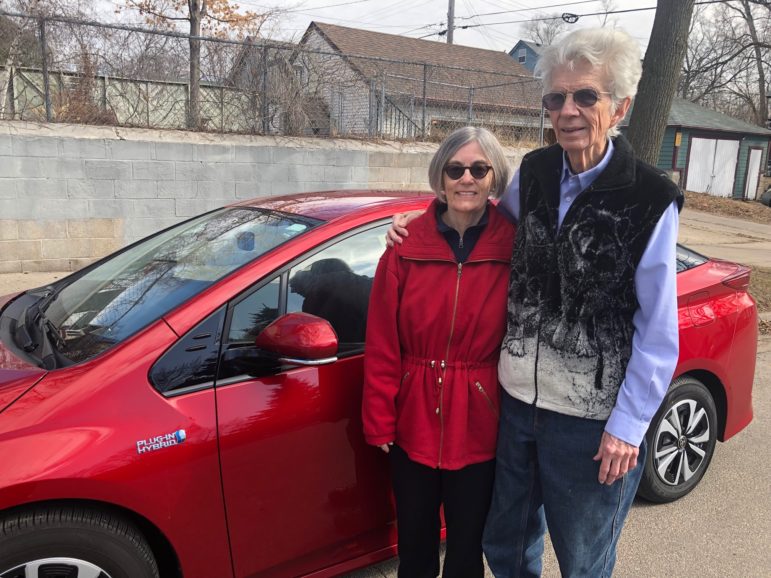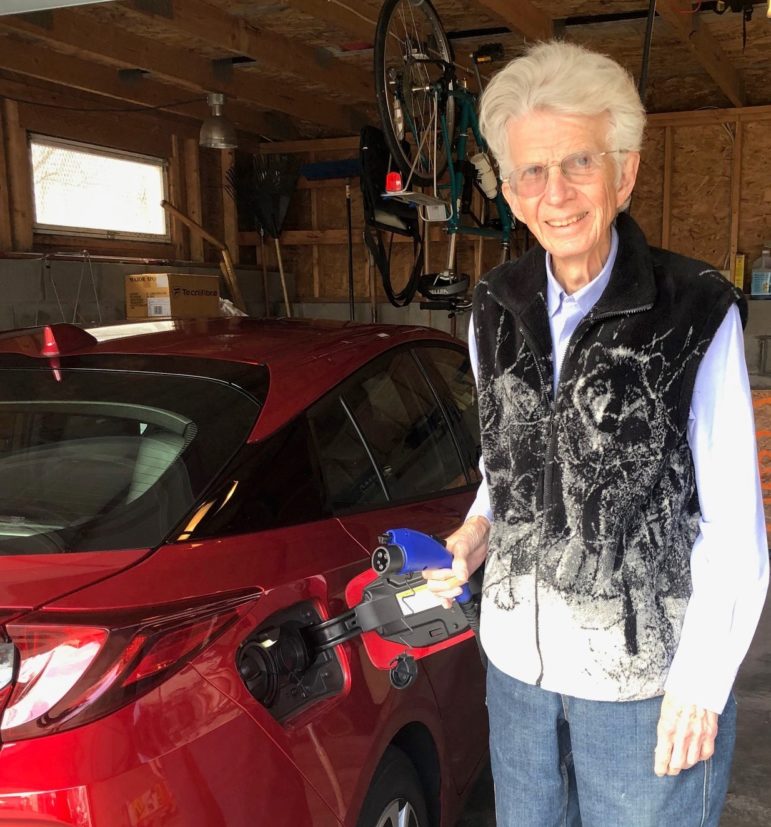
As battery prices continue to fall and electric vehicle charging infrastructure ramps up across the state, total electrification of our transportation sector is becoming a reality. For many families, though, a completely electric vehicle isn’t yet entirely practical because of long commutes or lack of access to charging stations during the day. Enter the plug-in hybrid electric vehicle. Plug-in hybrids, like the Toyota Prius Prime, typically use batteries to power an electric motor and rely on another fuel, like gasoline, to power an internal combustion engine. The vehicle runs on electric power until the battery is depleted, and then the car automatically switches over to gasoline for its power.
For city drivers, like David and Louise, a retired couple living in Minneapolis, a plug-in hybrid makes perfect sense (Fresh Energy’s executive director, Michael, loves his, too!). David purchased his family’s Prius Prime two years ago—and he didn’t have to make any special lifestyle changes or electrical upgrades to use the Prime. Each night, he plugs the car into a normal electrical outlet (no super charger needed) and his Prime fully charges in six hours.
Since most of David and Louise’s driving takes place in town, their Prime usually goes over two months before needing gasoline. The car’s battery has a range of about 25 miles—more than enough to get them through their day. “On the road, we suffer no ‘range anxiety’ since the total range, mostly on gasoline, is over 500 miles,” shares David. On the highway, they’re averaging between 48 – 60 miles per gallon.
And it’s economical, too, because David and Louise take advantage of Xcel Energy’s time-of-day rate plan. This means the couple receives a reduced electricity rate between 9 PM – 9 AM and on weekends when there is less power demand (as an added bonus, there is usually more renewable energy—like wind power—available, too).
“Turns out that shifting as much electric use to night or weekends could actually reduce my bill,” says David. He devised a spreadsheet to calculate the savings, and after switching to time-of-use pricing in late 2017, the couple has saved $80—about one month’s total electric bill. Currently, they pay 6 cents per kilowatt hour of electricity during off-peak time, which is approximately half of the normal electricity rate.

David shares that using time-of-day pricing requires “little attention, besides setting the charge schedule for my Prius.” He also makes sure to use the delayed start option on his home’s dishwasher, so their dishes are getting clean during off-peak night hours. They wash laundry on the weekends, to take advantage of weekend pricing, and have made other small changes to utilize electricity strategically.
His advice to others considering an electric vehicle but who are still unsure? “Don’t ignore plug-in hybrids. They may be best choice for many people until we have more charging stations in Minnesota and electric vehicles have a greater range.” And “be persistent” in signing up for time-of-day pricing with your utility: it can really pay off.
Fresh Energy uses a variety of strategies to ensure that Minnesotans have access to more electric transportation options and electricity pricing that is affordable and good for our electric grid and all consumers. Time-of-day pricing provides a particularly effective strategy for encouraging energy use to times when demand is low and renewable sources are available. As we transition to a fully electric economy, dynamic management of electricity demand will be essential to aligning peak demand with the availability of solar energy during the day and wind energy at night.
Do you have a clean energy story like David and Louise? Email us at info@fresh-energy.org to share more—we’d love to hear from you.

